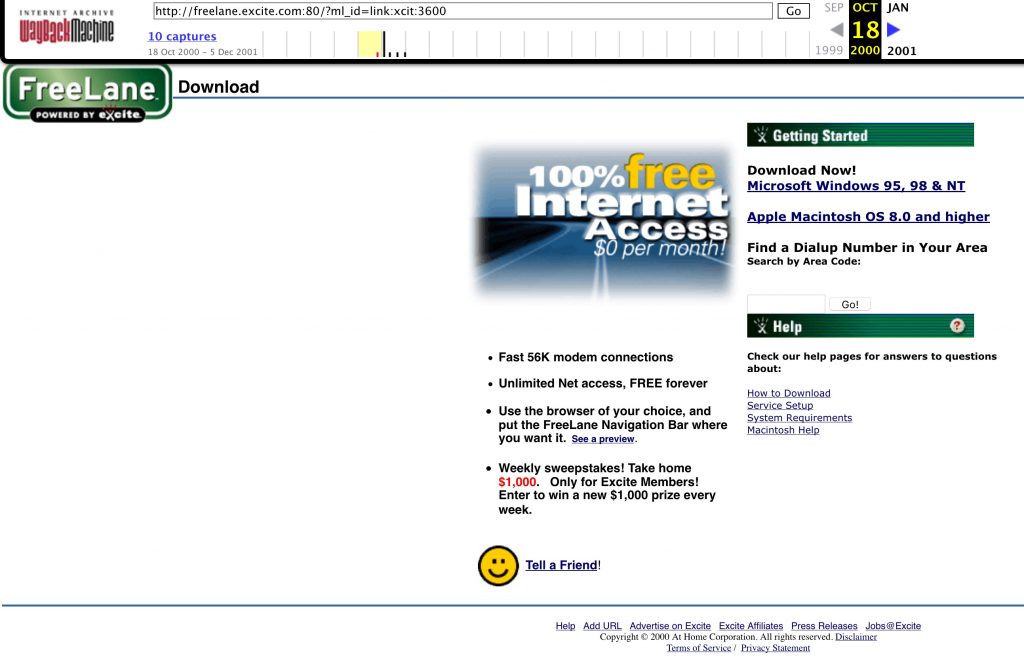Experts’ Amicus Brief Explains Internet Service
A group of us with significant Internet design experience going back the 1970s – John Day, Tom Evslin, Martin Geddes, Shane Tews and yours truly – filed an amicus brief yesterday in the challenge to the FCC’s 2017 Restoring Internet Freedom order. The challenge was mounted by Mozilla and the usual suspects: Public Knowledge, Free Press, Open Technology Institute, CDT, and various Silicon Valley interests.
The challengers maintain that the Telecommunications Act unambiguously classifies Internet Service under Title II and any deviation from that classification is wrong. So their position is at odds with the Supreme Court’s 2005 decision in the Brand X case to the effect that the Act is ambiguous so the Commission is free to go with either Title I or Title II as long as it has a reason for its classification.
The challengers’ case is not only based on a faulty reading of the law, it’s full of factual errors about the nature of the Internet and of broadband Internet service. We highlight the most glaring errors and correct them with sound, factual analysis.
Broadband Internet Access Service Inherently Integrates Transmission with Information Processing Functions
The FCC argues that broadband is inherently an information service because it enables users to access Google and Netflix, unambiguously information services themselves. So it takes an information service to access an information service. We agree.
Breaking this down, we show that Netflix is implemented by a Netflix app running on consumer equipment engaging in inter-process communication with a Netflix server. IPC is inherently an information service because it consists of more than just the raw transmission of data: IPC also exchanges status signals as it progresses, and it correlates requests and responses for multiple streams at the same time.
Broadband isn’t telecom, it’s IPC, just like the IPC provided to applications by the operating systems in our devices. Broadband Internet is a network operating system designed to support inter-process communication over long distances. As we’ve said since the 1970s, the Internet is a new paradigm for communication that breaks all the rules of telephony.
While Traffic On Telecommunications Service Networks Is Managed By The Network Provider, The BIAS Network Is Managed Collaboratively
The Internet confuses telecom regulators because it’s not a telecom network. Telecom is call-oriented, but the Internet is packet switched, always on, and always “connected” to all possible endpoints.
So it’s common for regulators to confuse telecom network management – which is all done by the network and all about assigning resources to calls – with the dynamic approach to resource management used by the Internet. The Internet’s most important network management job is congestion avoidance, which it does through coordinated action between network providers and user devices.
Dial-up ISPs handle congestion the same way broadband ISPs do, and dial-up ISPs have always been classified as information (or “enhanced”) services. So it’s irrational to impose Title II on broadband ISPs simply for doing things that are also done by dial-up ISPs.
Broadband Internet Services Include Information Processing Capabilities Unrelated To Transmission Or The Management Of Transmission
Internet Protocol also cannot be considered a transmission service because it can’t move packets of information by itself. The transport of IP packets is done by data link layer systems such as Ethernet, Wi-Fi, DOCSIS, and fiber-based xPON. So classifying IP as a transmission service is like classifying email as a transmission service. While email conveys information from source to destination without change, it relies on a transmission service that carries TCP over IP on a data link.
Data link layer transmission systems – which only carry information between the ISP and the consumer attachment point (think cable modem) – are bundled with Internet service by ISPs. Unless they offer transmission of this sort as a stand-alone service for use by other ISPs, broadband providers are not in the Title II game.
Universal connectivity requires orders of magnitude more computation than connecting calls does. ISPs fundamentally do dynamic routing of information packets, an activity so computationally complex as to render it an information service in its own right. But they also include other things in the service they offer the public that are unambiguously information services.
Domain Name Service is a vital function unrelated to transmission or the management of transmission
DNS, for example, is a distributed data base and not merely a telephone directory. Not only does DNS map domain names to IP addresses, it makes many other kinds of information available to ISP customers and to information service providers such as Google and Netflix.
Netflix uses DNS to locate the best copy of any given show the consumer wants to watch. As we’ve shown before, Netflix does as many as 25 DNS transactions before it begins to stream a program.
Authenticated email systems such as SPF, DKIM, and DMARC rely on DNS for the storage and retrieval of identifiers and crypto keys. DMARC is federal requirement, mandated by Homeland Security. Try doing it without DNS.
Caching is a vital function unrelated to transmission or the management of transmission
Caching is becoming more challenging now that Google, Facebook, and Netflix are encrypting their transmissions in order to stave off competition for ad placement services, but it’s very important to rural ISPs. So a new style of caching has appeared in which ISPs make floor space available for CDNs.
While petitioners argue that caching is merely a cost-saving measure, that’s not the way their sponsors see it. Netflix argues that its caching service is needed for performance and quality reasons.
TCP penalizes remote information services, and the only way to overcome the penalty is to cache information nearby. Caching and DNS work together to find the copy of any given piece of content that will stream fastest.
Malware mitigation is a vital function unrelated to transmission or the management of transmission
Chances are your ISP provides you with a subscription to an ant-malware service such as Norton or McAfee as part of the deal. They don’t do this for transmission management purposes, they do it for your own safety and for the health of the Internet.
This is something they didn’t do in the Brand X era, so it’s an example of Internet service becoming more computationally heavy rather than less (as petitioners argue.)
In addition, ISPs constantly monitor their networks for DDoS attacks and other symptoms of malware infestation. Mitigating bad behavior of this sort is better understood as policing the Internet as a whole rather than managing a transmission service.
Internet Architecture has not changed since Brand X
The Internet is a collection of protocols and interconnections. Today’s protocols are the same ones we used in 2005: HTTP, TCP, UDP, and IP.
Interconnection also works the same way: networks connect to other networks in public or private exchange points. They make deals with each other to interconnect, and they use BGP to exchange routes.
Not only has the Internet not changed in any fundamental way, it effectively can’t because too much inertia is present in such a large system.
Broadband is Simply a Replacement for Dialing up to Telenet
Petitioners’ brief becomes downright ridiculous when they try to show that Internet service is totally different today from the services offered in the Brand X era. They offer a blatantly false picture of Internet service as it was in 2000 (an arbitrary year in any case) to contrast with their equally nutty picture of the way it is today.
First, they say users of early Internet services such as America Online reached the Internet over Title II telephone services. While dial-up was part of the process, its role was actually quite limited.
We dialed local numbers that connected us to packet switched data networks such as Telenet or Tymnet, and the data networks connected us to AOL and Compuserve. As a famous paper says:
One notable Telenet customer in the early 1980’s was “The Source.” The founder and president of The Source, Bill von Meister, negotiated an arrangement with Larry Roberts whereby The Source could utilize Telenet network at night, when there was no business traffic, for only $0.50 per hour (vs. approximately $5 per hour during the day). The Source was then able to offer an attractively priced information service for consumers with PCs at home. Bill von Meister went on to found Control Video (which evolved into America Online). AOL’s consumer service was based on the same very low off-peak network pricing. Eventually, this network pricing allowed AOL to offer unlimited service for a nominal flat monthly price. AOL grew into one of the largest consumer-oriented online services and one of Telenet’s largest customers. Marc Seriff — a member of the original Telenet design team, and principal architect of the Telenet interactive terminal interface (1974) and Telenet’s Telemail email service (1979) — later became the primary architect of the AOL service infrastructure. – The history of telenet and the commercialization of packet switching in the U.S., note 29.
The first step in bringing the Internet to the people has always been to escape the clutches of Title II networks with their long distance tolls and (high) connection time billing models. See Larry’s post on billing models here on High Tech Forum.
Broadband was Never a Walled Garden
The most hilarious part of the challenger’s petition is the fable they try to cast about mythical walled gardens. They captured the excite.com home page of 2000 from the Wayback Machine and circle a link to “Free Web Access”.
They claim broadband users had to click this link to get to the Internet, which is supposed to prove that Internet was a supplemental feature of a walled garden. There are just two enormous problems with this claim.
First, users were already on the Internet when they saw this page. It’s just the Excite home page located at excite.com.
Second, the Free Web Access link just goes to an add for a free dial-up service provided by FreeLane.com. Try it for yourself and see. I laughed about that for days.
The draw of broadband was always the Internet. The @Home Network was created by Internet veteran Milo Medin and the cable companies to provide Internet service. It acquired Excite three years into its business life because Excite had an Internet search engine. The entire premise of Excite@Home was to make the Internet accessible to consumers.
Champions of Title II Simply Don’t Understand the Internet
Of all the challengers that have been enlisted by Silicon Valley to argue for ISP regulation, the current group looked like they could have done the best job of coming up with fact-based arguments. Mozilla makes the Firefox browser and CDT is head and shoulders above Free Press and Public Knowledge in technical knowledge.
But the lawyers must have seized control of the drafting of their petition from the techies at the two firms because it’s riddled with falsehoods and analytical errors.
Broadband was never a walled garden, the Internet is not a telecom network, and we can’t separate information processing from Internet service without misrepresentation. The Internet is a new direction for networking, and none of it fits the old models. It’s about time Congress got that message and went to work drafting an IPC-based regulatory framework.





